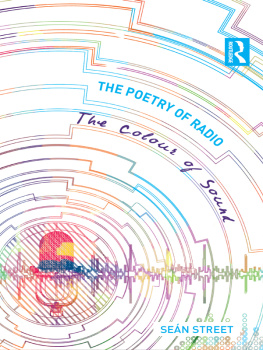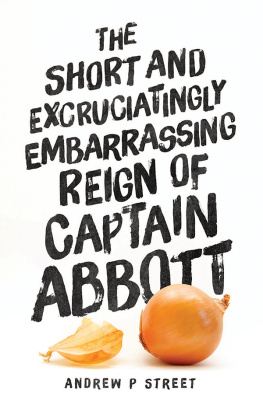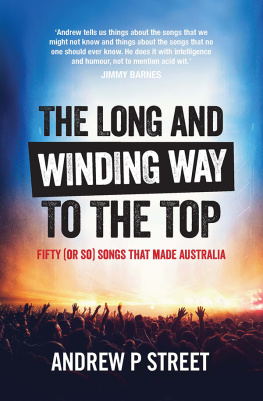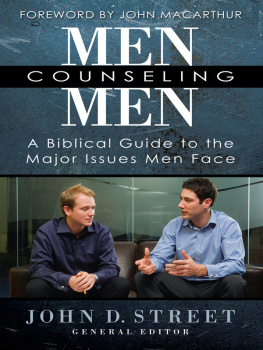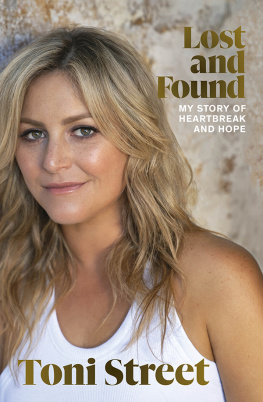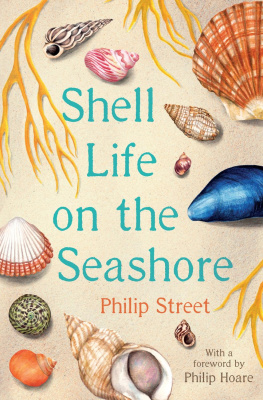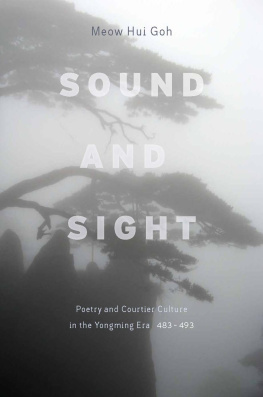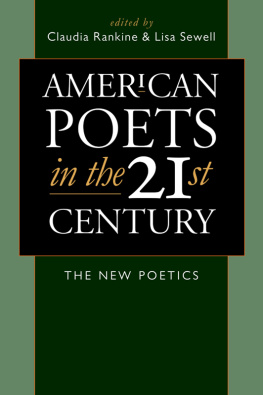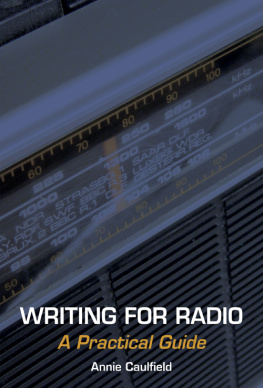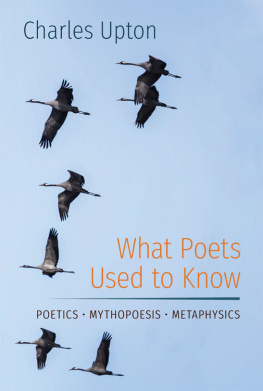Street - The poetry of radio: the colour of sound
Here you can read online Street - The poetry of radio: the colour of sound full text of the book (entire story) in english for free. Download pdf and epub, get meaning, cover and reviews about this ebook. City: London;New York, year: 2014, publisher: Taylor and Francis;Routledge, genre: Art. Description of the work, (preface) as well as reviews are available. Best literature library LitArk.com created for fans of good reading and offers a wide selection of genres:
Romance novel
Science fiction
Adventure
Detective
Science
History
Home and family
Prose
Art
Politics
Computer
Non-fiction
Religion
Business
Children
Humor
Choose a favorite category and find really read worthwhile books. Enjoy immersion in the world of imagination, feel the emotions of the characters or learn something new for yourself, make an fascinating discovery.
The poetry of radio: the colour of sound: summary, description and annotation
We offer to read an annotation, description, summary or preface (depends on what the author of the book "The poetry of radio: the colour of sound" wrote himself). If you haven't found the necessary information about the book — write in the comments, we will try to find it.
Street: author's other books
Who wrote The poetry of radio: the colour of sound? Find out the surname, the name of the author of the book and a list of all author's works by series.
The poetry of radio: the colour of sound — read online for free the complete book (whole text) full work
Below is the text of the book, divided by pages. System saving the place of the last page read, allows you to conveniently read the book "The poetry of radio: the colour of sound" online for free, without having to search again every time where you left off. Put a bookmark, and you can go to the page where you finished reading at any time.
Font size:
Interval:
Bookmark:
The Poetry of Radio
Sen Street has written a seminal and elegant book on the poetics of radio. It is intellectually and creatively rooted in qualitative research and makes an original contribution to the scholarship on the relationship between poetry and the new medium of sound literature that has blossomed as a result of the onset of the radio age from the early part of the twentieth century. He is a veritable poet and professor of radio himself and brings to the text all of the passion, intelligence and T.S. Eliots description of the auditory imagination present in his own creative feature making. This book will be a lasting treasure for students, professionals and artists in the field of radio and sound programme making. It is a brilliant and masterful achievement.
Tim Crook, Goldsmiths College, University of London
This book explores the idea of poetry in radio and sound as well as the concept of pure sound as poetry, both historically and within a contemporary perspective, examining examples of makers and works internationally.
The Poetry of Radio examines the development of poetic forms in sound broadcasting historically and geographically through chapters taking narrative themes. It includes primary source material gathered through interviews conducted by the author with distinguished producers and poets. Among these are producers Piers Plowright, Matt Thompson, Alan Hall, Simon Elmes and Julian May (UK), Edwin Brys (Belgium), Hildegard Westerkamp (Germany/Canada), Chris Brookes (Canada), Robyn Ravlich, Michael Ladd and Kaye Mortley (Australia), as well as poets, including Michael Symmons Roberts and Jeremy Hooker. There is a chapter on poetic sound in the natural world, which focuses in particular on the work of the renowned UK sound recordist, Chris Watson.
Alongside audio poetry, the book discusses the spoken word including documentaries and public announcements, the radio feature, soundscapes and sonic art, with contributions from key figures such as Colin Black (Australia) and Marcus Leadley (UK) and the poetry of the vernacular in speech and sound. It considers new platforms for listening including podcasts and developments in mobile technologies, examining the work of current practitioners including Francesca Panetta, who is responsible for The Guardians podcasts as well as the award-winning Hackney Podcast, and Tim Wright.
Sen Street is Emeritus Professor of Radio in The Media School, Bournemouth University, UK, as well as a published poet and radio practitioner, whose programmes have aired on the BBCs Radio 3 and Radio 4. A small selection of his previous publications include An A-Z of British Radio (2009), New and Selected Poems: Time Between Tides (2009), The Historical Dictionary of British Radio (2006), Crossing the Ether Pre-War Public Service Radio and Commercial Competition in the UK (2006), Radio Waves Poems celebrating the Wireless (2004), A Concise History of British Radio (2002) and Radio and Other Poems (1999).
The Poetry of Radio
The Colour of Sound
Sen Street

First published 2012
by Routledge
2 Park Square, Milton Park, Abingdon, Oxon, OX14 4RN
Simultaneously published in the USA and Canada
by Routledge
711 Third Avenue, New York, NY 10017
Routledge is an imprint of the Taylor & Francis Group, an informa business
2012 Sen Street
The right of Sen Street to be identified as author of this work has been asserted by him in accordance with sections 77 and 78 of the Copyright, Designs and Patents Act 1988.
All rights reserved. No part of this book may be reprinted or reproduced or utilised in any form or by any electronic, mechanical, or other means, now known or hereafter invented, including photocopying and recording, or in any information storage or retrieval system, without permission in writing from the publishers.
Trademark notice: Product or corporate names may be trademarks or registered trademarks, and are used only for identification and explanation without intent to infringe.
British Library Cataloguing in Publication Data
A catalogue record for this book is available from the British Library
Library of Congress Cataloging in Publication Data
Street, Sen.
The poetry of radio : the colour of sound / Sen Street.
p. cm.
Includes bibliographical references and index.
Radio and literature. 2. Sound--Psychological aspects. I. Title.
PN1991.8.P6S75 2012
809.933558--dc23
2011031827
ISBN 978-0-415-60410-9 (hbk)
ISBN 978-0-203-14348-3 (ebk)
For my wife Joanne, with love
In the end there was the Word, at first a glint,
Then an illumination overhead
Where the high towers are lit
(Louis MacNeice, Autumn Sequel, Canto IV)
Text Acknowledgements
Ahoudig, Mehdi, Who Killed Lolita, broadcast November 2009. Reprinted by kind permission of Radio Grenouille/ARTE Radio (France).
Cage, John, Lecture on Nothing, Silence: Lectures and Writings, 2009. Reprinted by kind permission of Marion Boyars.
Gascoyne, David, Night Thoughts, Selected Poems, Enitharmon, 1994. Reprinted by kind permission of Enitharmon Press.
Hooker, Jeremy, Wind Blew Once, The Cut of the Light: Poems 19652005, Enitharmon, 2006. Reprinted by kind permission of Enitharmon Press.
MacNeice, Louis, Autumn Sequel, Faber & Faber, 2007. Reprinted by kind permission of David Higham Literary, Film and TV Agents.
Smith, Ken, Shed: Poems 19802001, Bloodaxe, 2002. Reprinted by kind permission of Bloodaxe Books.
Solbakken, Marte, Epilogue for Mr. Bodin, broadcast Saturday, 15 May, 2010 at 10:03 AM, accessible at: www.nrk.no/programmer/radio/radiodokumentaren/1.7113260. Reprinted by kind permission of NRK Radio (Norway).
Preface
There are many forms of radio: ever since its creation it has served as a means of informing and entertaining, but even before that, the wireless technology envisaged by Marconi and his contemporaries was that of telegraphy, rather than telephony. Thus, its birth was utilitarian, and its purpose that of a functional means of communication. In this it has proved invaluable, life-saving and world-changing. Eventually when the sounds became words rather than signals, a dichotomy ensued; words could also impart information of course, but they were also able to entertain. Likewise, the transmission of music live and recorded brought a new purpose to the medium and a new meaning to entertainment in the home and ultimately on the move. The birth of radio in the United States, in 1920, was inaugurated by the broadcast of election results in the presidential race between Warren J. Harding and James M. Cox. It quickly became apparent on both sides of the Atlantic that providing a service that could inform and/or entertain would make the manufacture and sale of receiving equipment an industry with the potential for almost unlimited growth if the content could be made appealing to an audience in sufficient numbers. The early years of American radio were chaotic, largely unregulated, but vibrant. By 1922, when the British Broadcasting Company was formed, it seemed as though lessons had been learned. John Reith, writing in 1924, claimed of the beginnings of US broadcasting that:
With characteristic energy it had developed wholesale, largely on a commercial basis, and without any method of control whatsoever. There is no co-ordination, no standard, no guiding policy; advertising, direct or indirect, is usually the sole means of revenue. I gather from many American visitors that they consider that the delay which took place before a service was begun in this country, is more justified by the progress subsequently made.
Next pageFont size:
Interval:
Bookmark:
Similar books «The poetry of radio: the colour of sound»
Look at similar books to The poetry of radio: the colour of sound. We have selected literature similar in name and meaning in the hope of providing readers with more options to find new, interesting, not yet read works.
Discussion, reviews of the book The poetry of radio: the colour of sound and just readers' own opinions. Leave your comments, write what you think about the work, its meaning or the main characters. Specify what exactly you liked and what you didn't like, and why you think so.

